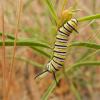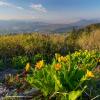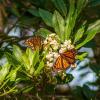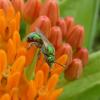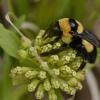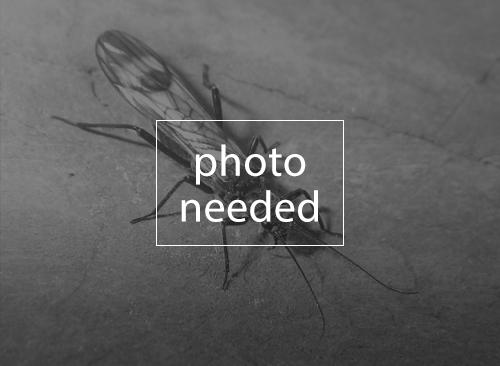
The desert green hairstreak is found in remote desert canyons in the Great Basin and arid inter-mountain West from northern Nevada and eastern California to southern Utah and western Colorado. Its preferred habitat is sagebrush scrub and pinyon-juniper woodland in which their larval hostplants grow. The hostplants are various wild buckwheats (Eriogonum sp.). Due to the relative isolation and inaccessibility of its habitats, there are few identified threats. The most prominent threat is the intrusion of invasive alien weeds into the habitats, especially cheatgrass (Bromus tectorum), which can increase the frequency and intensity of wildfires.
Taxonomic Status
(Lepidoptera: Lycaenidae: Theclinae: Eumaeini)
Callophrys comstocki Henne, 1940. Common names include Comstock’s hairstreak and Comstock’s green hairstreak.
The desert green hairstreak is a small butterfly in the family Lycaenidae (gossamer wings). It has a wingspan of 22 to 29 mm (¹³⁄₁₆ to 1 inch). The upperside is gray. The underside is gray-green with a sinuous row of white dots on the hindwing.
The desert green hairstreak has up to two flight periods, from March-May and August-September. The second flight is usually small and in dry years may be not existent. During these periods males perch to watch for females in depressions or gulch bottoms. After mating, females will lay their eggs singly on hostplant leaves. Caterpillars usually eat leaves, although some prefer flowers and young fruits. They will overwinter as chysalids. During extended dry periods they may overwinter twice.
These butterflies are found in remote desert canyons in the Great Basin and arid intermountain West from northern Nevada and eastern California to southern Utah and western Colorado. The subspecies C. c. interrupta is endemic to Nevada.
The preferred habitat is sagebrush scrub and pinyon-juniper woodland, generally in ravine bottoms, in which their larval hostplants grow. The hostplants are various wild buckwheats (Eriogonum sp.). In most of the range the principal hostplants are redroot buckwheat (E. racemosum) and bastardsage (E. wrightii). In Nevada, however, the principal hostplant is Heermann’s buckwheat (E. heermannii) and in California it is suspected to use sulphur-flowered buckwheat (E. umbellatum).
Xerces Red List Status: Imperiled
Other Rankings:
Canada – Species at Risk Act: N/A
Canada – provincial status: N/A
Mexico: N/A
USA – Endangered Species Act: None
USA – state status: None
NatureServe: G2G3 (T1T2 for spp. interrupta)
IUCN Red List: N/A
The desert green hairstreak is considered Imperiled because of its limited range and generally small population (although in wet years it can be locally abundant), particularly in the eastern part of its range. The Nevada subspecies C. c. interrupta may be of greater concern.
Due to the relative isolation and inaccessibility of its habitats, the desert green hairstreak has few identified threats. The most prominent threat is the intrusion of invasive alien weeds into the habitats, especially cheatgrass (Bromus tectorum), which can increase the frequency and intensity of wildfires
Where habitats are being invaded by cheatgrass, action should be taken to reduce the spread and minimize the fire threat. With the increase of back country recreation (e.g. off-highway vehicles), public land managers must be careful to manage the impacts on this butterfly’s habitat.
Surveys should be done to identify new populations and monitoring of known populations, especially on public lands, is necessary.
Emmel, T.C. and J.F. Emmel. 1973. The Butterflies of Southern California. Natural History Museum of Los Angeles County, Los Angeles, CA.
Ferris, C.D. and F.M. Brown. 1981. Butterflies of the Rocky Mountain States. University of Oklahoma Press, Norman, OK.
Garth, J.S. and J.W. Tilden. 1986. California Butterflies. University of California Press, Berkeley and Los Angeles, CA.
Opler, P.A. 1999. A Field Guide to Western Butterflies. Houghton-Mifflin Co., Boston, MA.
Scott, J. A. 1986. The Butterflies of North America. Stanford University Press, Stanford, CA.
Stanford, R. E. and P. A. Opler. 1993. Atlas of Western USA Butterflies Including Adjacent Parts of Canada and Mexico. Denver and Fort Collins, CO.
Profile prepared by Mace Vaughan and Matthew Shepherd, The Xerces Society for Invertebrate Conservation.
Citation
Vaughan, D. M., and M. D. Shepherd. 2005. Species Profile: Callophrys comstocki. In Shepherd, M. D., D. M. Vaughan, and S. H. Black (Eds). Red List of Pollinator Insects of North America. CD-ROM Version 1 (May 2005). Portland, OR: The Xerces Society for Invertebrate Conservation.

